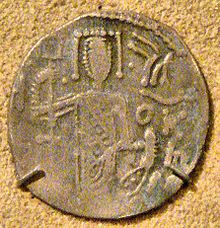- Manuel I of Trebizond
-
Manuel I Megas Komnenos (Greek: Μανουήλ Α΄ Μέγας Κομνηνός, Manouēl I Megas Komnēnos) (c. 1218 – March 1263), Emperor of Trebizond from 1238 to 1263, surnamed the "Great Captain", was the second son of Alexios I, the first emperor of Trebizond, and Theodora Axuchina. He succeeded his brother, John I Axouchos. In spite of his alleged military abilities, Trebizond became or remained a vassal to the Seljuk Turks and, after the Battle of Köse Dag in 1243, to the Mongols of Persia. Trapezuntine forces served in the battle as Seljuk tributaries. The Seljuk forces were shattered in the defeat and the Sultanate of Iconium began to decline.
In 1253, Manuel negotiated for a dynastic alliance with King Louis IX of France, by which he hoped to secure the help of the Crusaders against the Seljuks and Laskarids of Nicaea, but Louis advised him to seek a wife from the Latin Empire of Constantinople. Jean de Joinville testifies to Manuel's wealth, saying he sent Louis: "various precious things as a gift; amongst others, bows made of the wood of the service tree, whose arrow-notches screwed into the bow, and when they were released, one saw that they were very sharp and well made."
The destruction of Baghdad by Hulagu Khan in 1258 revived the trade route running north from Armenia and the upper Euphrates valley to Erzerum and then through the Zigana Pass to Trebizond. This trade route caused the beginnings of Trebizond's commercial prosperity, because goods from the Silk Road were now transported to Trebizond and the Black Sea, instead of to the Mediterranean. Although some bronze coins have been attributed to Alexios I, and silver aspers were certainly coined by John I, Manuel struck both bronze coins and a large silver currency. Trapezuntine coins circulated widely outside the empire, especially in Georgia.
Manuel rebuilt the Hagia Sophia monastery in Trebizond between 1250 and 1260. Eastmond describes Manuel's church as 'the finest surviving Byzantine imperial monument of its period.' 1 When Michael VIII Palaiologos recaptured Constantinople from the Latin Empire in 1261 he unsuccessfully demanded that Manuel abandon his claim to the Byzantine succession.
Manuel married three times and left several children, four of whom reigned after him. By his first wife, Anna Xylaloe, a Trapezuntine noblewoman he had:
- Andronikos II, who succeeded as emperor.
By his second wife, Rusudan of Georgia, he had:
By his third wife, Irene Syrikaina, another Trapezuntine noblewoman, he had four children:
- George
- Anonymous daughter, who married King Demetre II of Georgia
- Anonymous daughter
- John II.
References
- Oxford Dictionary of Byzantium, Oxford University Press, 1991.
- W. Miller, Trebizond: The Last Greek Empire of the Byzantine Era, Chicago, 1926.
- A. Eastmond, Art and identity in thirteenth-century Byzantium: Hagia Sophia and the empire of Trebizond, Burlington, VT: Ashgate, 2004
 This article incorporates text from a publication now in the public domain: Chisholm, Hugh, ed (1911). Encyclopædia Britannica (11th ed.). Cambridge University Press.
This article incorporates text from a publication now in the public domain: Chisholm, Hugh, ed (1911). Encyclopædia Britannica (11th ed.). Cambridge University Press.
Online References
- Latin and French Documents on the Empire of Trebizond available at http://www.ancientworlds.net/aw/Post/971835
Manuel I of TrebizondKomnenid dynastyBorn: c. 1218 Died: March 1263Regnal titles Preceded by
John IEmperor of Trebizond
1238–1263Succeeded by
Andronikos IICategories:- 1218 births
- 1263 deaths
- Emperors of Trebizond
- Komnenos dynasty
- Orthodox monarchs
Wikimedia Foundation. 2010.

